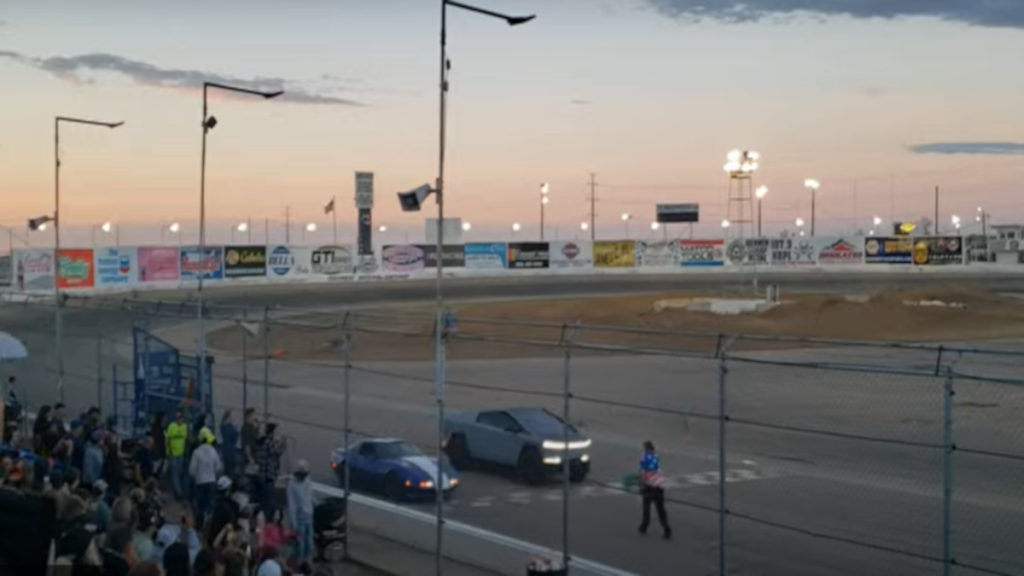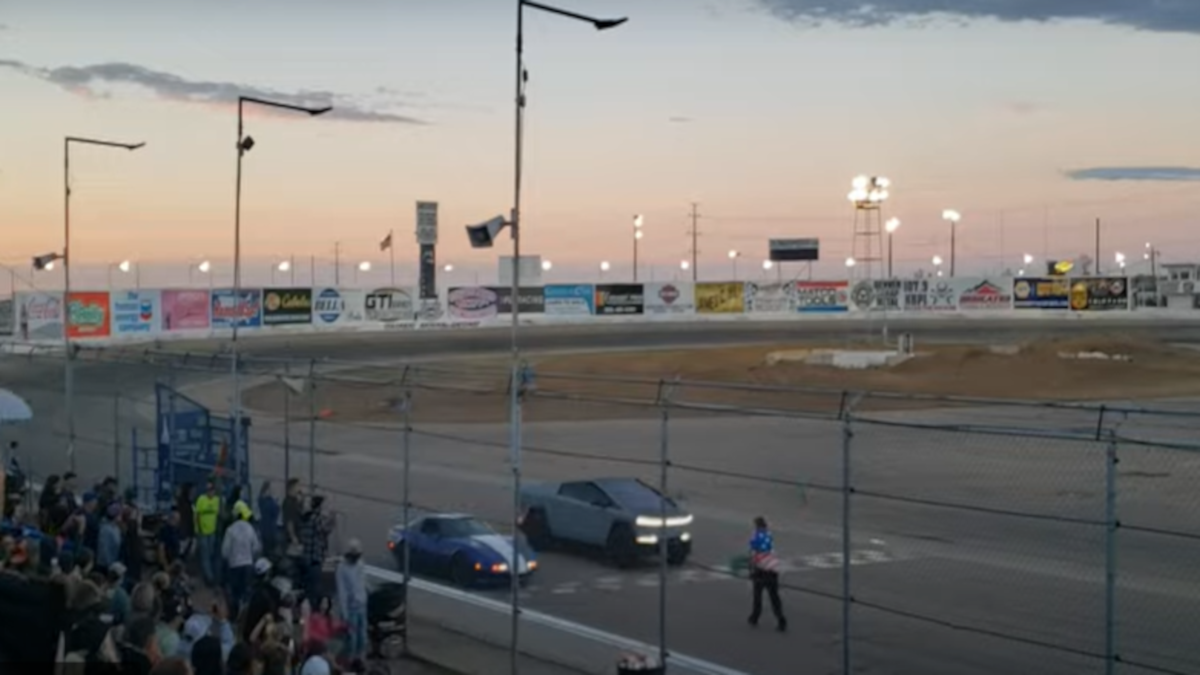Electric Muscle vs. Classic Performance
The juxtaposition of cutting-edge electric technology against the raw, classic performance of a nearly 30-year-old sports car paints a vivid picture of modern automotive capabilities and timeless racing principles.
This was never more evident than in a recent single-lap circle race at Colorado’s National Speedway, where a Tesla Cybertruck took on a 1996 Chevrolet Corvette Grand Sport.
The outcome? A surprising victory for the Corvette, highlighting that in racing, power alone is not the ultimate determinant of success.

The Competitors: Modern vs. Classic
Tesla Cybertruck: A Technological Marvel
The Tesla Cybertruck, with its striking design and advanced electric powertrain, represents the pinnacle of modern automotive engineering.
Boasting an impressive 845 horsepower (630 kW), the Cybertruck is designed to excel in various environments, from off-road trails to urban streets. Its electric motors provide instant torque, allowing for rapid acceleration and an almost silent driving experience.
The Cybertruck’s exterior, constructed from ultra-hard 30X cold-rolled stainless steel, not only offers a unique aesthetic but also ensures durability and protection against the elements.
1996 Chevrolet Corvette Grand Sport: A Classic Icon
In contrast, the 1996 Chevrolet Corvette Grand Sport embodies the essence of American muscle. With its iconic blue livery and white racing stripe, this C4-generation Corvette is a tribute to Chevrolet’s racing heritage.
Under the hood, it houses a 5.7-liter LT4 V8 engine, producing 330 horsepower (246 kW). While this is significantly less than the Cybertruck’s output, the Corvette’s lightweight design and nimble handling make it a formidable contender on the race track.
Despite its age, the Corvette Grand Sport remains a symbol of performance and engineering prowess from a bygone era.
The Race: A Battle of Contrasts
Setting the Stage
The race took place at Colorado’s National Speedway, a venue known for hosting various motorsport events. The circular track posed a unique challenge, emphasizing handling and driver skill over raw speed.
With the Corvette starting on the outside lane, it faced a greater distance to cover, while the Cybertruck, with its superior power, seemed poised for an easy victory.
Off the Line: Electric Torque vs. Internal Combustion
As the race began, the Tesla Cybertruck’s electric motors demonstrated their advantage with an immediate burst of speed.
Within moments, the Cybertruck had gained a two-car-length lead over the Corvette, showcasing the impressive acceleration characteristic of electric vehicles.
However, the first turn quickly revealed a critical difference between the two vehicles: braking performance and handling.
Navigating the Turns: Driver Skill in Focus
Entering the first turn, the Cybertruck’s driver applied the brakes, a necessary move to navigate the corner safely. Meanwhile, the Corvette, with its lower weight and more traditional racing setup, maintained its speed through the turn, closing the gap.
On the backstretch, the Corvette stayed glued to the Cybertruck’s rear, capitalizing on its superior cornering ability.
The Final Stretch: A Surprising Finish
As the race approached the final turn, the Corvette made its move. Darting to the inside, the Corvette’s driver executed a flawless maneuver, slipping past the Cybertruck and taking the lead just before the finish line.
The crowd erupted in cheers, celebrating the unexpected victory of the classic sports car over the high-tech truck.
This race outcome underscored a fundamental truth in racing: power and technology are important, but they are not the only factors that determine success.
Analyzing the Outcome: Lessons Learned
The Role of Driver Skill
One of the most significant takeaways from this race is the importance of driver skill. The Corvette’s driver demonstrated exceptional control and strategic thinking, using the car’s strengths to overcome its power deficit.
This race highlighted that in motorsports, the driver’s ability to navigate the track, anticipate movements, and execute precise maneuvers can be just as crucial as the vehicle’s specifications.
Physics and Vehicle Dynamics
The race also underscored the importance of physics and vehicle dynamics. The Cybertruck, despite its power, struggled with braking and handling due to its heavier weight and larger size.
In contrast, the Corvette’s lighter frame and lower center of gravity allowed it to maintain higher speeds through the turns, a critical advantage on a circular track.
Course Layout and Its Impact
The layout of the race track played a pivotal role in the outcome. On a drag strip, the Cybertruck’s superior acceleration would have likely secured an easy victory.
Similarly, on an off-road course, the Cybertruck’s design and capabilities would have given it a significant edge. However, the circular track at National Speedway emphasized handling and braking, areas where the Corvette excelled.
Broader Implications: EVs vs. Traditional Sports Cars
The Rise of Electric Vehicles
The Tesla Cybertruck represents the growing prominence of electric vehicles (EVs) in the automotive industry.
With advancements in battery technology, electric motors, and autonomous driving systems, EVs are becoming increasingly competitive in various aspects of performance.
The Cybertruck’s power and acceleration are a testament to the potential of electric powertrains.
The Enduring Appeal of Classic Cars
Despite the advancements in automotive technology, classic cars like the Corvette Grand Sport continue to captivate enthusiasts. Their mechanical simplicity, iconic designs, and visceral driving experience offer a unique appeal that modern vehicles sometimes struggle to replicate.
This race highlighted that older sports cars still have a place in the world of motorsports, providing excitement and performance that can rival newer models.
Conclusion: Celebrating the Diversity of Automotive Excellence
The race between the Tesla Cybertruck and the 1996 Chevrolet Corvette Grand Sport was more than just a competition of speed and power.
It was a celebration of the diversity within the automotive world, showcasing how different technologies and eras can come together to create thrilling and unexpected outcomes.
While the Cybertruck’s loss might seem surprising given its specifications, it serves as a reminder that racing is a multifaceted discipline where many factors, including driver skill, vehicle dynamics, and course layout, play crucial roles.
As the automotive industry continues to evolve, with electric vehicles becoming more prominent and traditional sports cars maintaining their allure, events like this race highlight the ongoing excitement and innovation in the world of motorsports.
Whether you’re a fan of cutting-edge electric technology or a lover of classic performance, there’s something for everyone to appreciate and enjoy on the track.
Related Reading
Conclusion: A Testament to the Multifaceted Nature of Racing
This race, although seemingly a simple one-lap circle competition, encapsulates the multifaceted nature of racing. It’s a vivid illustration that in motorsports, success isn’t determined solely by the latest technology or the highest horsepower.
Instead, it is the intricate blend of driver expertise, vehicle dynamics, and track layout that culminates in a race’s outcome.
The victory of the Corvette over the Cybertruck serves as a poignant reminder that, despite the rapid advancements in automotive technology, the fundamental principles of racing remain timeless.
As the automotive landscape continues to shift, with electric vehicles gaining prominence and classic cars retaining their charm, the diversity within the field of motorsports ensures that every race is an opportunity to celebrate the rich tapestry of automotive excellence.
Whether it’s the cutting-edge performance of an electric truck or the enduring appeal of a classic sports car, each brings its unique strengths to the track, making every race a testament to the ever-evolving world of automotive innovation.
Further Reflections: The Broader Impact
The Future of Electric Vehicles in Racing
The Tesla Cybertruck’s performance in this race, despite its loss, underscores the significant strides electric vehicles (EVs) have made in recent years.
As battery technology improves and electric motors become more efficient, EVs are poised to play a larger role in competitive racing.
The instant torque and rapid acceleration offered by electric powertrains provide a distinct advantage in certain types of races, particularly those focused on short bursts of speed.
However, the race also highlights areas where EVs can continue to improve, particularly in handling and weight distribution.
The Timeless Allure of Classic Cars
The victory of the Corvette Grand Sport serves as a reminder of the timeless allure of classic cars. These vehicles, with their mechanical simplicity and visceral driving experience, continue to captivate enthusiasts and prove their worth on the track.
The Corvette’s success in this race demonstrates that, even in the face of modern technology, the fundamental principles of good design, balanced performance, and driver skill can still triumph.
As automotive technology continues to evolve, the enduring appeal of classic cars ensures that they will always have a place in the hearts of enthusiasts and on the race track.
Final Thoughts: Embracing the Diversity of Automotive Innovation
The race between the Tesla Cybertruck and the 1996 Chevrolet Corvette Grand Sport was a fascinating display of the diversity and innovation within the automotive world.
It served as a reminder that, while technology continues to advance, the essence of racing remains rooted in a combination of power, skill, and strategy.
As we look to the future of motorsports, it is exciting to imagine how electric vehicles and classic cars will continue to shape and define the landscape, each bringing their unique strengths and characteristics to the track.
In celebrating the outcome of this race, we also celebrate the rich tapestry of automotive history and innovation.
Whether you’re a fan of cutting-edge electric technology or a lover of classic performance, there’s no denying the excitement and passion that both bring to the world of motorsports.
And as we move forward, it is this diversity and innovation that will continue to drive the thrill and excitement of racing, ensuring that every race is a unique and unforgettable experience.


































